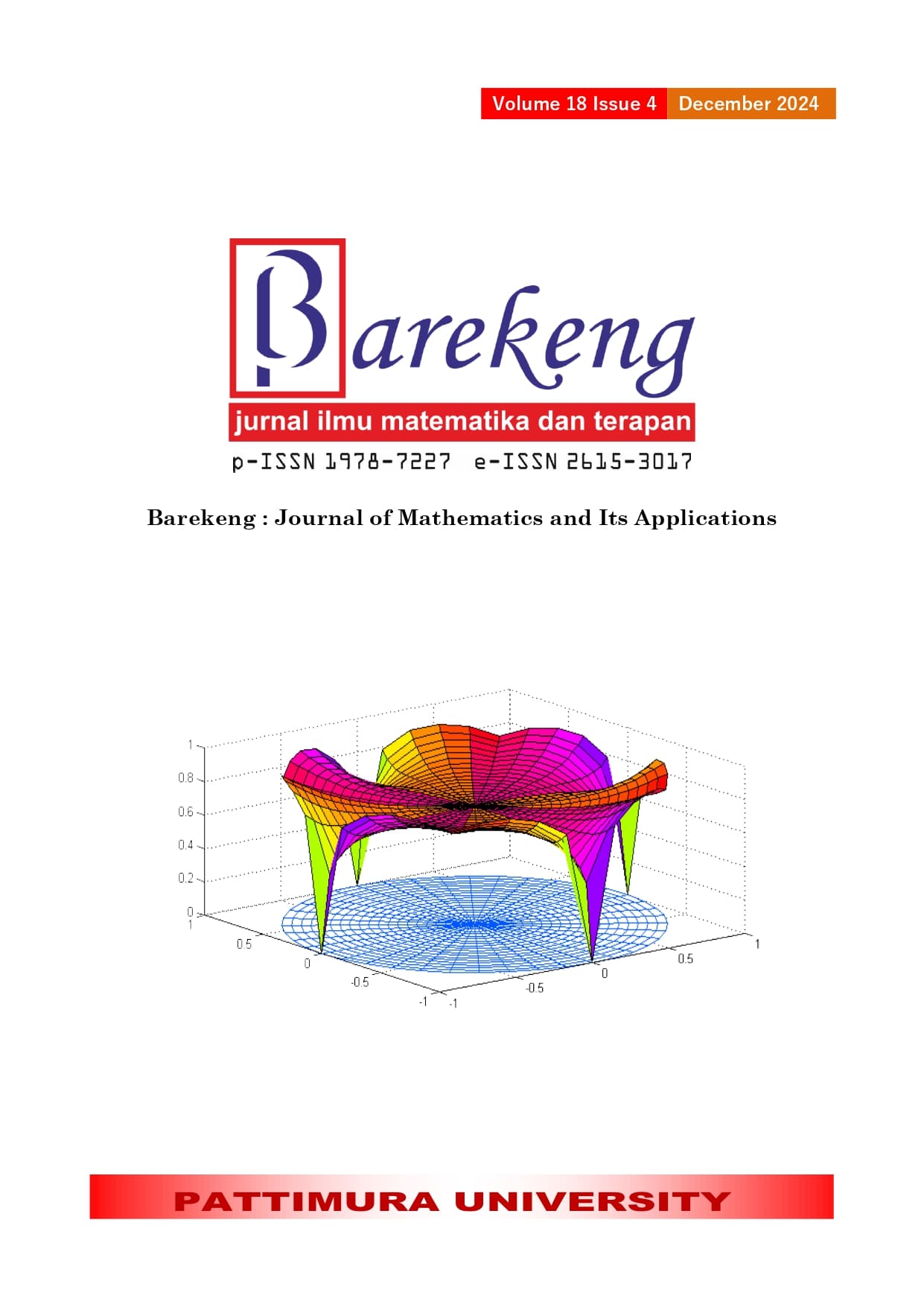MONITORING THE SAUSAGE PRODUCT USING LANEY DEMERIT CHART BASED ANALYTICAL HIERARCHY PROCESS
Abstract
Ready-to-eat sausage is a food product that has a limited shelf life. Therefore, regularly monitoring the quality of packaged ready-to-eat sausage products is important to ensure that the products meet the established quality standards. Twelve types of product defects need to be observed in the final checking process to meet the quality standards, namely Wrinkle, Dots, Leaking, Product Stain, Non-standard Form, Poor Print Quality, Vacuum Leaks, Weak Ties, Body Defects, Uneven Length, Broken Node, and Small Stain. This study aims to apply the Laney Demerit Control Chart (LDCC) and Analytical Hierarchy Process-Integrated Statistical Process Control (AHP-ISPC) methods to monitor the quality of packaged ready-to-eat sausage production at XYZ Inc. The data is from the quality testing of ready-to-eat sausage products taken from XYZ Inc. for six months from April 1, 2023, until September 30, 2023. The findings reveal that conventional control charts (u control chart, demerit control chart, and AHP-based demerit control chart) exhibited oversensitivity because it is attributed to the large number of samples produced by the company, prompting the need for a more balanced approach. Implementing the Laney u control chart, Laney demerit control chart, and the AHP-based Laney demerit control charts successfully achieved statistical control in phase I. In contrast, phase II still demonstrated challenges, particularly with the AHP-based Laney Demerit Control Chart detecting the highest number of out-of-control points. This suggests that phase II remains statistically out of control, necessitating further analysis or corrective measures to enhance process stability. Additionally, the process capability analysis indicated that the production process during the specified period lacked capability, as evidenced by a capability index value below one (0.883).
Downloads
References
M. M. Hayman, I. Baxter, P. J. O’riordan, and C. M. Stewart, “Effects of high-pressure processing on the safety, quality, and shelf life of ready-to-eat meats,” J Food Prot, vol. 67, no. 8, pp. 1709–1718, 2004.
D. B. Laney, “Improved control charts for attributes,” Qual Eng, vol. 14, no. 4, pp. 531–537, 2002.
B. Ma, Y. Han, S. Cui, Z. Geng, H. Li, and C. Chu, “Risk early warning and control of food safety based on an improved analytic hierarchy process integrating quality control analysis method,” Food Control, vol. 108, p. 106824, 2020.
S. A. H. Lim, J. Antony, and S. Albliwi, “Statistical Process Control (SPC) in the food industry–A systematic review and future research agenda,” Trends Food Sci Technol, vol. 37, no. 2, pp. 137–151, 2014.
H. F. Dodge, “A method of rating manufactured product,” Bell System Technical Journal, vol. 7, no. 2, pp. 350–368, 1928.
L.-H. Chen, “A demerit control chart with linguistic weights,” J Intell Manuf, vol. 16, pp. 349–359, 2005.
A. Darko, A. P. C. Chan, E. E. Ameyaw, E. K. Owusu, E. Pärn, and D. J. Edwards, “Review of application of analytic hierarchy process (AHP) in construction,” International journal of construction management, vol. 19, no. 5, pp. 436–452, 2019.
Y. Liu, C. M. Eckert, and C. Earl, “A review of fuzzy AHP methods for decision-making with subjective judgements,” Expert Syst Appl, vol. 161, p. 113738, 2020.
O. S. Vaidya and S. Kumar, “Analytic hierarchy process: An overview of applications,” Eur J Oper Res, vol. 169, no. 1, pp. 1–29, 2006.
D. C. Montgomery, Introduction to statistical quality control. John Wiley & Sons, 2020.
Bunga Tata Arinda, Statistical Quality Control of the Welding Process in the Construction of “X” Ship at PT PAL Indonesia (Persero) Using Demerit Control Map and Fuzzy Analytics Hierachy Process-Integrated Statistical Process Control. Surabaya: Institut Teknologi Sepuluh Nopember, 2022.
T. Saaty and L. Vargas, Models, methods, concepts & applications of the analytic hierarchy process. 2012. doi: 10.1007/978-1-4614-3597-6.
A. E. Munthafa and H. Mubarok, “Application of the analytical hierarchy process method in the decision support system for determining outstanding students,” Jurnal Siliwangi Seri Sains dan Teknologi, vol. 3, no. 2, pp. 192–201, 2017.
Winarto and Ciptomulyono, Application of Analytical Hierarchy Process (AHP) in Determining Organizational Form (Case study at PT CVX, Steam and Supply Team). Surabaya: Institut Teknologi Sepuluh Nopember, 2013.
M. Sagnak and Y. Kazancoglu, “Fuzzy analytic hierarchy process‐integrated statistical process control: An application of demerit chart at furniture manufacturing company,” Journal of Multi‐Criteria Decision Analysis, vol. 27, no. 1–2, pp. 96–103, 2020.
M. F. Solikhin and M. Ahsan, “Statistical Quality Control of Plastic Spoon Production Process Using Laney Demerit Control Chart and Analytical Hierarchy Process-Integrated Statistical Process Control,” in Proceedings of the 5th International Conference on Statistics, Mathematics, Teaching, and Research 2023 (ICSMTR 2023), Springer Nature, 2023, p. 165.
M. Ahsan, B. T. Arinda, and I. K. Prasetya, “Monitoring Welding Process on Ship Construction Using Demerit Control Chart and Fuzzy Analytics Hierarchy Process Integrated Statistical Process Control.,” IAENG International Journal of Applied Mathematics, vol. 54, no. 7, 2024.
Copyright (c) 2024 Farhan Landi, Muhammad Ahsan, Kevin Agung Fernanda Rifki

This work is licensed under a Creative Commons Attribution-ShareAlike 4.0 International License.
Authors who publish with this Journal agree to the following terms:
- Author retain copyright and grant the journal right of first publication with the work simultaneously licensed under a creative commons attribution license that allow others to share the work within an acknowledgement of the work’s authorship and initial publication of this journal.
- Authors are able to enter into separate, additional contractual arrangement for the non-exclusive distribution of the journal’s published version of the work (e.g. acknowledgement of its initial publication in this journal).
- Authors are permitted and encouraged to post their work online (e.g. in institutional repositories or on their websites) prior to and during the submission process, as it can lead to productive exchanges, as well as earlier and greater citation of published works.






1.gif)



